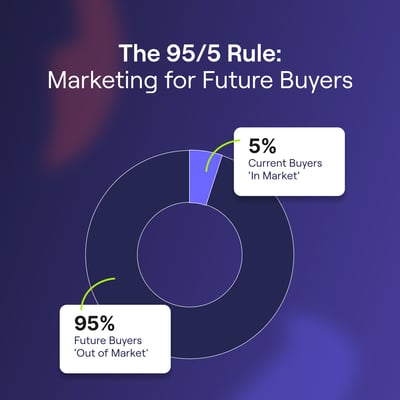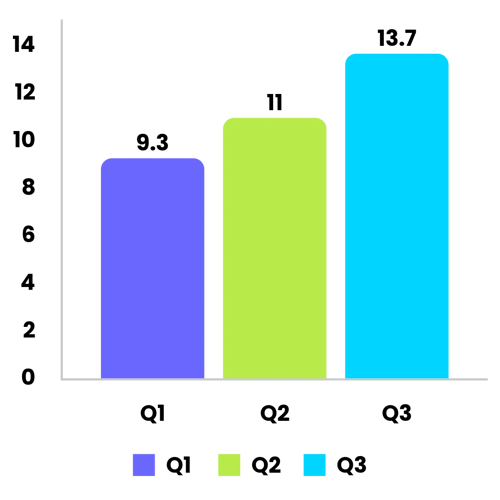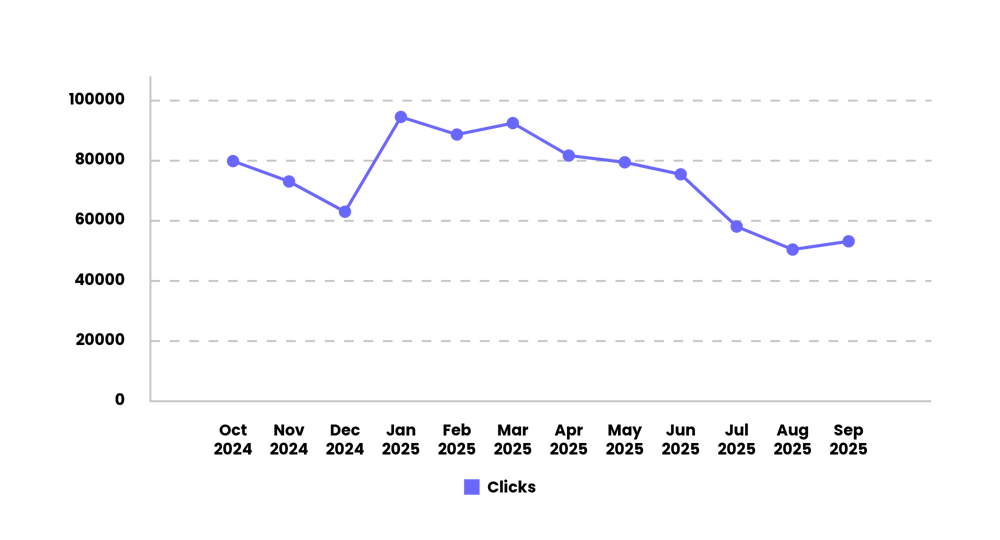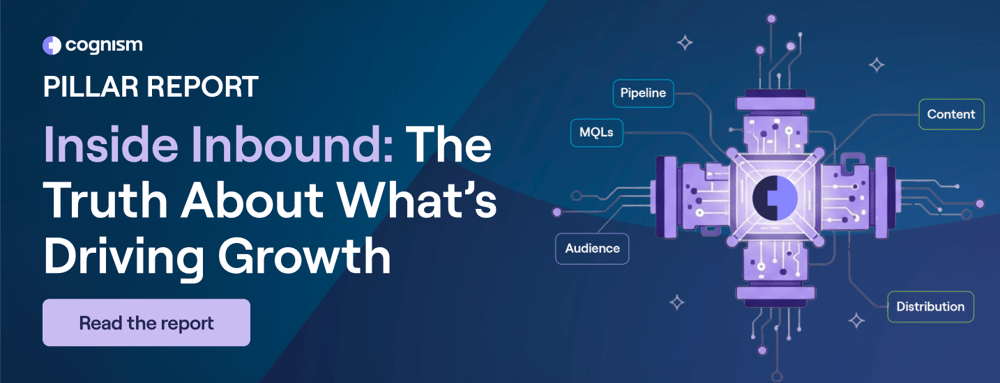12 B2B Marketing Trends and Predictions for 2026
B2B marketing predictions:
B2B marketing is changing at a dizzying pace.
What’s driving these shifts?
Increasing buyer savviness, shorter sales cycles, and, of course, AI search!
To succeed next year, you need to know where to focus your marketing efforts and how to act on data insights.
Imagine having a marketing strategy that predicts buyer behaviour, personalises every touchpoint, and nurtures leads seamlessly through the funnel. Forward-thinking B2B marketers are embracing this reality.
Let’s take a closer look at the trends shaping B2B marketing in 2026, including actionable steps for integrating them into your strategy.
These insights are based on our recent Inside Inbound 2026 report.
1. Ads become your precision engine
Last year, we talked about high-intent targeting and conversion-focused creative. In 2026, that trend has matured into something sharper.
Paid search is infrastructure. Google delivers the highest MQL-to-closed-won rate (6%), and Bing often outperforms it (8.9%). This is where your brand captures demand the moment it appears.
👉 Learn more about our demand generation paid strategy in the DG playbook.
Paid social continues to be for demand creation, not gated content or low-intent form fills. LinkedIn, Meta, and niche platforms prime audiences so search and direct traffic convert at far higher rates. It’s a crucial part of the funnel, creating mindshare with the 95% who are not in the market to buy right now.

Creative, not budget, drives efficiency.
Teams that win treat paid channels like a precision system, not a volume engine:
- Segmented campaigns.
- Relentless negative keyword hygiene.
- Durable creative concepts.
- Landing page refreshes every 4–6 weeks.
- Clear channel roles (search = capture, social = create, retargeting = accelerate).
This is performance marketing for the inbound era.
Top-of-Funnel (ToFu) ads for building awareness
At the awareness stage, you need to educate and captivate. Take a software-as-a-service (SaaS) company targeting procurement managers.
ToFu ads could feature an animated video explaining hidden manual procurement costs. Promoting this content via LinkedIn Ads with parameters such as job title and industry ensures the right audience sees it.
Interactive content, like quizzes or calculators, also performs well here.
For example:
A quiz titled “How Efficient is Your Procurement Process?” can engage leads and help you collect first-party data for retargeting later.
Middle-of-funnel (MoFu) ads for nurturing interest
Prospects in the consideration phase need proof. Provide them with case studies, in-depth whitepapers, or product comparison guides to showcase your expertise and differentiate your brand.
For example:
A logistics tools company might create a whitepaper about how its software reduced shipping delays for a major retailer by 25%.
Retargeting ads can also invite potential customers who engaged with your ToFu content to download this whitepaper. Or attend a webinar — bringing them closer to conversion.
Here’s a MoFu ad we ran at Cognism on Instagram:
And here’s the landing page that it led to, which focuses on how we cut our customers’ list build time by 75%:
Since this focuses on one of our MoFu leads’ top pain points and shows an impressive data point, it helps us build trust in seconds.
Bottom-of-funnel (BoFu) ads for driving decisions
When prospects are ready to make a decision, specificity is key. Ads featuring product demos, TAM calculators, or limited-time offers can be the final push hesitant buyers need to act.
For example:
If your SaaS solution includes a month’s free trial, run a BoFu ad that shows how much users typically save within 30 days of implementing your software.
Add social proof, like a testimonial from a well-known client in your industry, to help strengthen trust.
2. AI search becomes a core marketing channel
Last time, we predicted AI-driven content optimisation. In 2026, the shift is far bigger.
AI search is now a distribution channel. Everyone freaked out in 2025 when Google’s market share dropped below 90% for the first time in 10 years, and Large Language Models (LLMs) are indeed starting to become part of the buyer’s journey.
ChatGPT, Gemini, and Perplexity influence buying decisions before buyers ever reach your site. According to our own data, self-reported attribution from AI/LLM sources increased by 9.25% year-over-year. Additionally, some studies indicate that ChatGPT accounts for nearly 80% of chatbot referral traffic.

To win, brands must optimise for citations, not just clicks:
- Clear, concise answers.
- Entity-rich content.
- Structured data for LLMs.
- Fact density that AI can lift.
- Authoritative sources and proof.
None of these points is anything new to SEOers. Still, certain areas are more critical for being mentioned in LLMs, such as brand mentions on your domain, and actually taking into account your broader brand strategy to shape how you’re perceived.
3. Zero-click search rewrites the content playbook
If your organic search clicks were falling off a cliff in 2025, then you weren’t alone. Zero-click search is here to stay.
We, too, weren’t immune to this shift. Here’s our own graph:

Marketers might associate this drop in organic metrics with a decline in demand. It doesn’t. It represents a transfer of discovery from websites to AI- and community-driven ecosystems.
And the numbers are stark:
- Organic sessions down 33.6% year-over-year.
- Organic clicks down 23% year-over-year.
This isn’t a dip. This is a reallocation of where the buying journey happens.
The “first mile” of discovery is no longer on your website
Actionable, product- and problem-specific insights are being consumed off-site, long before a buyer ever types in your branded term or lands on your blog. This new off-site discovery layer reshapes the entire content strategy.
Today, the buyer’s journey unfolds across:
- AI answer boxes that consolidate and summarise your content.
- Reddit threads where practitioners recommend tools, debate solutions, and share real outcomes.
- Slack and Discord communities where in-the-trenches operators exchange what’s actually working.
- Social feeds where short-form video and expert commentary outperform long-form posts.
- YouTube Shorts and TikTok-style summaries that compress complex topics into 30 seconds.
- Private knowledge-sharing networks inside organisations.
Buyers are learning, comparing, and validating solutions before visiting your website.
Google still matters, but less as a traffic engine and more as a signal of authority and credibility. AI and communities increasingly decide what gets surfaced first.
4. Personalisation will get predictive
Last year, we expected deeper personalisation driven by data and automation. 2026 delivers something more future-proof: AI-driven personalisation without personal data.
With cookies changing and privacy tightening, marketers have shifted to:
- Session behaviour.
- Content engagement patterns.
- Ad sequencing.
- CRM lifecycle data.
- Historical buying cohorts.
- AI-predicted intent.
Modern tools can now infer a buyer’s likely intent before they fill out a form or reveal their email address.
Practical Examples
-
“Viewed pricing 2+ times = prioritise SDR outreach”
-
“Watched product demo = trigger BOFU ads”
-
“Repeated return to comparison page = send competitive proof content”
Predictive personalisation works because it interprets behaviour, not identity.
5. People will crave smaller in-person events
A year ago, we discussed the resurgence of hybrid events and the gradual rebuilding of in-person experiences. In 2026, we’re well past “resurgence.” We’re in the middle of a full-blown return to physical connection, and the results are reshaping B2B pipeline generation at every stage of the funnel.
Why in-person is surging again
Digital channels have reached a saturation point. We’re competing in inboxes, feeds, message threads, Slack channels, communities, and AI-driven summaries that compress our content into 50-word snippets. Buyers are overwhelmed, fatigued, and increasingly sceptical of overly polished digital interactions.
In this environment:
- Trust has become the scarcest commodity.
- Attention has become the most volatile resource.
- Noise is the default.
- Signals are harder to interpret and attribute.
But there’s one environment where trust is built instantly, where signals are unmistakably real, and where intent becomes obvious:
Face-to-face conversations.
In-person events cut through every form of digital friction. A single 10-minute discussion can produce more insight, context, and momentum than a month of email exchanges.
👉 Learn more about our events strategy.
6. B2B social continues to look like B2C
B2B social media has been evolving for years, but 2026 is the tipping point - the year the corporate voice finally dies.
The most effective brands no longer speak through polished, sanitised posts. They talk through people. And it’s not a trend for the sake of trend; it’s grounded in buyer behaviour reflected across your survey and the broader ecosystem: trust now flows from practitioners, not institutions.
Buyers are overloaded with noise, AI-generated content, and lifeless company updates. What they actively seek out are the people who:
- Do the job every day.
- Articulate the nuance.
- Share lived experience.
- Speak like humans.
- Show their face, not a brand logo.
7. Content must prove your value
Content is now a risk reducer. In markets where budgets are scrutinised and teams must justify every investment, content has one overriding job: provide verifiable evidence that your solution works.
Take our Date-a-vendor hub, for example.
Buyers don’t just want to “learn” anymore. They want to feel confident they won’t make a bad decision. That means content must do more than inform, it must:
- Justify the decision internally.
- Defend the budget.
- Reduce uncertainty at every step.
- Validate implementation success.
- Pre-empt stakeholder objections.
Best-performing content types
- ROI snapshots that quantify value without fluff.
- Competitive comparison pages that address switching hesitation.
- Customer transformation stories rich with specifics, not adjectives.
- Pricing transparency pages that reduce early-stage friction.
- Proof-driven ad creative that shows outcomes, not opinions.
- Demo walk-through videos that mirror real scenarios.
- Objection-handling content woven into nurture and sales enablement.
This is a return to fundamentals: buyers respond to clarity, credibility, and specificity. No jargon. No polished vagueness. No “ultimate guides” that don’t ultimately help.
8. Inbound sales becomes about momentum
Last time, we predicted inbound teams would shift from long, bloated cadences to tight, high-quality outreach. The 2026 data validates this: inbound is no longer a volume game; it’s a momentum game.
Our Inside Inbound report found that teams using shorter, clearer, and hyper-relevant cadences are consistently achieving conversion rates of 50–90%, depending on the motion. That’s unheard of; just a few years ago, when inbound systems prioritised touch count over touch quality.
What’s changed?
Buyers now value:
- Immediacy — they expect a real response, not a 5-email sequence.
- Contextualisation — outreach tailored to their location, industry, or intent.
- Human-first interaction — call-first and video-first beat email-first.
- Relevance — fewer, better touches outperform old 12–15 step cadences.
- Recognition — referencing their journey increases response dramatically.
Long cadences feel automated. Short, sharp cadences feel intentional.
Momentum metrics matter more
Modern inbound teams measure:
-
Speed to lead (time from form fill to action).
-
Speed to connect (the first human conversation).
-
Speed to value (helpfulness in the earliest touch).
-
Speed to meeting.
-
Speed to pipeline.
Momentum isn’t about pressure — it’s about matching the buyer’s pace. In 2026, the fastest team wins not because they’re aggressive, but because they’re aligned with buyer urgency.
9. Influencer partnerships will be more important than ever
Niche influencers are powerful allies in B2B marketing.
As buyers consume more answers off-site (AI summaries, community threads, and short-form video), influence now travels through people and communities more reliably than through brand channels.
That means B2B influencer and creator partnerships, done right, are no longer an experimental tactic. They are a core driver of visibility, trust, and pipeline.
-
Budgets are shifting to creators. Marketers are increasing creator spend year-over-year; creator ad spend is a fast-growing category as brands chase authenticity and distribution.
-
B2B teams are scaling influencer programs. Recent industry studies indicate that many B2B marketers are increasing their dedicated influencer budgets and transitioning from one-off activations to always-on partnerships.
10. Brand demand becomes a valuable KPI
Awareness and trust are essential elements of modern B2B growth. In 2026, these two ideas converge into a single, measurable metric: brand demand, which is most commonly tracked through brand search volume.
When buyers search for you by name rather than category, you bypass noisy SERPs, paid bidding wars, and AI-generated answer layers. And most importantly, branded demand feeds AI answer engines — a dynamic that’s becoming critical as organic search behaviour changes.
When your brand is strong:
- Competitors can’t easily intercept deals.
- Late-stage persuasion becomes easier.
- Trust compounds across every channel.
Brand is no longer a nice-to-have. Brand is a revenue system.
11. AI becomes a second creative team
The AI mindset has matured. AI is a second creative department that expands your output, elevates your standards, and accelerates your experimentation cycles. We’ve already been embedding AI into our marketing workflows, in the form of custom marketing GPTs.
What this actually looks like
AI now supports the full creative lifecycle:
-
Concepting: Creative teams can produce 10 concepts in a day, rather than two per week.
-
Rapid experimentation: Ad variants, headlines, hooks, video cuts, and copy can be tested in hours.
-
Transcreation: AI adapts creative for different regions and audiences without losing nuance.
-
Creative analytics: AI tools identify patterns in winning ads: angles, framing, CTAs, language, pacing.
AI gives you more shots on goal, more data to learn from, and more room to experiment. And in a year when every channel is noisier and more volatile, experimentation speed becomes one of the most substantial competitive advantages a B2B brand can hold.
12. Video will be integral to marketing and sales
Video content is still one of the most engaging formats in B2B marketing.
Tutorials and walkthroughs are particularly effective for complex products because they help your prospects see your solution in action.
For example, one of your video series may demonstrate how your CRM tool streamlines sales pipelines. Your videos could range from high-level overviews to detailed, step-by-step guides on specific features.
Adding customer testimonials and real-world use cases within the walkthroughs can also help you boost credibility.
Wrap up
2026 will be another transformative year for B2B marketing.
Success in 2026 will hinge on three core principles: visibility, velocity, and veracity.
-
Visibility: Show up where buyers form opinions — AI-powered search, social feeds, niche communities, and branded search — before they even click.
-
Velocity: Move fast. Fast, well-orchestrated inbound sales cadences and timely content create momentum, driving conversions.
-
Veracity: Be credible. Data-backed insights, expert-led content, and verifiable claims earn trust in a zero-click, AI-driven world.
The winners won’t be the biggest or loudest teams — they’ll be the clearest, fastest, and most trustworthy. Brands that master these three pillars will turn disruption into opportunity and thrive in the next era of B2B marketing.

/SMB%20ABM/Blog_Image_How%20SMBs%20Can%20Run%20Enterprise-Level%20ABM%20on%20a%20Lean%20Budget%20%20Resource%20Card.webp)
/B2B%20marketing%20predictions/b2b-marketing-trends-2026-card.webp)
